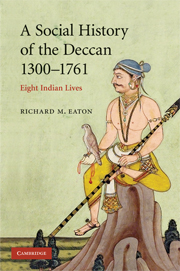Book contents
- Frontmatter
- Introduction
- 1 Pratapa Rudra (R. 1289–1323): the demise of the regional kingdom
- 2 Muhammad Gisu Daraz (1321–1422): Muslim piety and state authority
- 3 Mahmud Gawan (1411–1481): Deccanis and Westerners
- 4 Rama Raya (1484–1565): élite mobility in a Persianized world
- 5 Malik Ambar (1548–1626): the rise and fall of military slavery
- 6 Tukaram (1608–1649): non-brahmin religious movements
- 7 Papadu (fl. 1695–1710): social banditry in Mughal Telangana
- 8 Tarabai (1675–1761): the rise of Brahmins in politics
- Select bibliography
- Index
- Plate Section"
- References
5 - Malik Ambar (1548–1626): the rise and fall of military slavery
Published online by Cambridge University Press: 28 March 2008
- Frontmatter
- Introduction
- 1 Pratapa Rudra (R. 1289–1323): the demise of the regional kingdom
- 2 Muhammad Gisu Daraz (1321–1422): Muslim piety and state authority
- 3 Mahmud Gawan (1411–1481): Deccanis and Westerners
- 4 Rama Raya (1484–1565): élite mobility in a Persianized world
- 5 Malik Ambar (1548–1626): the rise and fall of military slavery
- 6 Tukaram (1608–1649): non-brahmin religious movements
- 7 Papadu (fl. 1695–1710): social banditry in Mughal Telangana
- 8 Tarabai (1675–1761): the rise of Brahmins in politics
- Select bibliography
- Index
- Plate Section"
- References
Summary
The slaves of this kingdom [Damot, in Ethiopia] are much esteemed by the Moors, and they do not let them go at any price; all the country of Arabia, Persia, India, Egypt, and Greece, are full of slaves from this country, and they say they make very good Moors and great warriors.
Father Francisco Alvares (1523)FROM “CHAPU” to “MALIK AMBAR”
An Ethiopian slave known to history as “Malik Ambar” was already seventeen years old in 1565, the year of the Battle of Talikota. If that date signaled the beginning of a slide into near-oblivion for the city of Vijayanagara, for the Ethiopian it heralded the dawn of an extraordinary career. His original name was not, of course, Malik Ambar, for malik means “king, ” conceptually quite distant from a slave. In his native land he was known as “Chapu,” a name that suggests an origin in the Kambata region of southern Ethiopia.
Born in 1548, Chapu as a youth had fallen into the hands of slave dealers operating between the Ethiopian highlands and the coasts of eastern Africa. He might have been captured in war, or he might have been sold into slavery by his impoverished parents. In any event, he joined streams of other Ethiopians–known in the Arab world as “Habshis”–who turned up in slave markets in the Middle East, there to enter élite households as servants or, as in Chapu's case, to be re-exported to the Deccan plateau to meet that region's insatiable demand for military labor. Chapu thus appears to have been sold and resold several times after his initial entry into slavery. A contemporary European source relates that he was sold in the Red Sea port of Mocha for the sum of eighty Dutch guilders.
Keywords
- Type
- Chapter
- Information
- A Social History of the Deccan, 1300–1761Eight Indian Lives, pp. 105 - 128Publisher: Cambridge University PressPrint publication year: 2005
References
- 2
- Cited by



